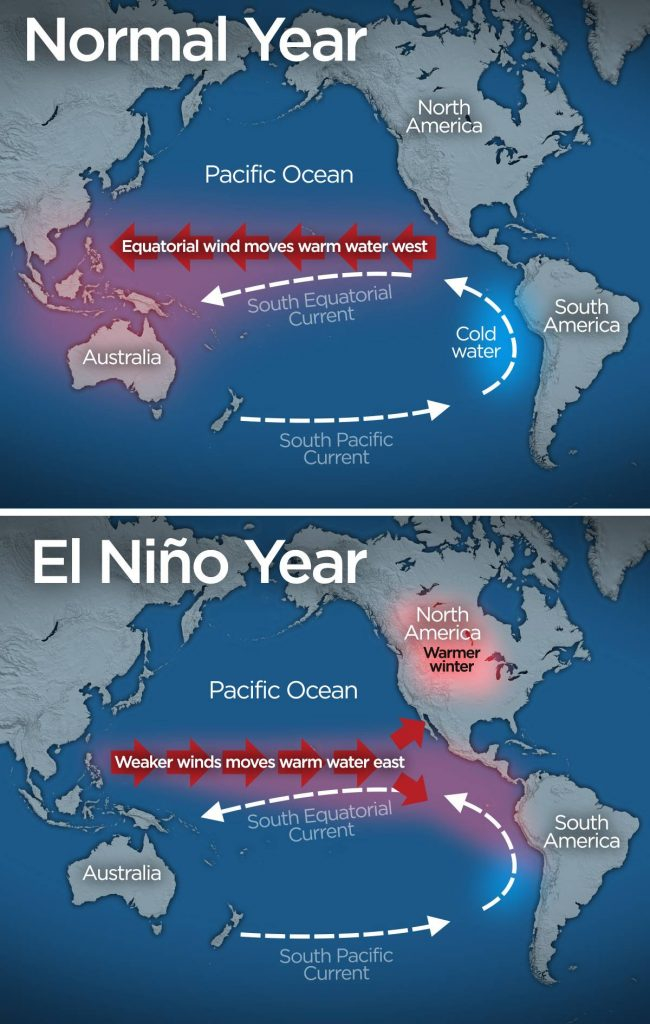- Home
- Prelims
- Mains
- Current Affairs
- Study Materials
- Test Series
La Nina
- La Niña basically refers to an abnormal cooling of the central and eastern Pacific Ocean waters off the coasts of Ecuador and Peru.
- Such cooling (sea surface temperatures i.e. SSTs falling) is a result of strong trade winds blowing west along the equator, taking warm water from South America towards Asia.
- The warming of the western equatorial Pacific, then, leads to increased evaporation and concentrated cloud-formation activity around that region, whose effects may spread to India as well.
- Atmospheric changes: La Nina events lead to higher pressure in Central and Eastern Pacific (over western South America) and Lower Pressure over Western Pacific (Over Eastern Australia). This pressure gradient intensifies trade winds which pushes westward movement of warm water and strong upwelling of cold water in eastern Pacific (South America’s Pacific Coast).
- Positive Feedback: There is a positive reinforcement between the atmospheric and ocean phenomena. This is evident as the stronger trade winds lead to increased upwelling and cooling of the Eastern Pacific region, which further strengthens trade winds.
- Usually La Nina events last for 9-12 months. However, they can prolong as well for about two years.
Impact of La Nina in India
- La Nina events usually lead to warming of the Indian Ocean, particularly the Western Indian Ocean region due to changes in wind patterns. This also leads to reduced upwelling in the region to leading to reduced fisheries catch.
- Monsoon Enhancement: Usually La Niña events leads to strengthening of monsoons in India leading to more rainfalls.
- Boost for Agricultural: An enhanced monsoon can benefit agriculture, especially in regions where rainfed agriculture is practiced. More rainfall can lead to higher crop yields or may be one more cycle of farming leading to higher incomes for farmers and food security.
- Flood Risks: Increased rainfall can also result in flooding events in low-lying areas leading to damage to life & property.
- Winter Temperatures: During La Niña years, northern India may experience colder winters. This is due to a stronger high-pressure system over Central Asia, which can bring cold winds down into the northern plains of India.
- Drought Mitigation: La Niña conditions can help alleviate drought situations in regions experiencing water scarcity, as the increased rainfall can replenish reservoirs, rivers, and groundwater levels.
 Impact of La Nina (Globally)
Impact of La Nina (Globally)
Global Variations:
- Australia: During La Niña, Australia typically experiences wetter than average conditions, leading to increased rainfall and sometimes flooding in parts of the country.
- South America:
- La Niña can bring variable impacts to different parts of South America. In countries like Argentina and Brazil, it can lead to wetter conditions in some regions, benefiting agriculture with increased crop yields. However, in other areas such as parts of Bolivia and Paraguay, drought conditions may prevail, negatively impacting crop production.
- Upwelling along the Pacific Coast of South America during La Nina brings cold deep nutrient rich water to the surface, promoting phytoplankton growth leading to boom in fish population in eastern Pacific.
- North America: La Niña often results in a more active winter storm track across the northern United States and Canada, leading to increased snowfall and colder temperatures. Conversely, southern United States tends to experience warmer and drier conditions, which can increase droughts risks in already arid regions like the southwestern states.
- Southeast Asia: Countries like India, Indonesia and the Philippines may experience increased rainfall during La Niña events, affecting rice production and potentially causing flooding and landslides in vulnerable areas.
Economic Impact:
- Energy Sector: La Niña can influence energy markets globally. For instance, in regions where La Niña results in increased hurricane activity, such as the Gulf of Mexico and the Caribbean, disruptions to oil and gas production can occur, leading to fluctuations in energy prices.
- Commodities: Agricultural commodities such as grains (corn, soybeans) and soft commodities (coffee, cocoa) can see price volatility due to changes in production caused by La Niña-induced weather patterns.
Social and Environmental Consequences:
- Small island nations in the Pacific can be particularly vulnerable to the impacts of La Niña, including increased storm surges, coastal erosion, and damage to infrastructure due to intensified tropical cyclones.
Ecological Effects:
- Marine Ecosystems: La Niña alters ocean temperatures and currents, affecting marine life distribution and productivity
Health Implications:
- Vector-Borne Diseases: La Niña can influence the spread of vector-borne diseases such as malaria and dengue fever. Increased rainfall can create breeding grounds for mosquitoes, potentially leading to outbreaks in affected regions.









 Latest News
Latest News
 General Studies
General Studies